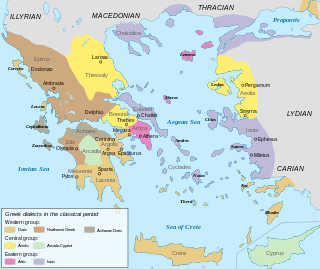
Back اليونانية الأيوليكية Arabic Еолийски диалект Bulgarian আয়েওলীয় গ্রিক Bengali/Bangla Eolsko narječje BS Grec eòlic Catalan Aiolština Czech Äolisches Griechisch German Αιολική διάλεκτος Greek Griego eólico Spanish Dialeutu eólicu EXT
This article should specify the language of its non-English content, using {{lang}}, {{transliteration}} for transliterated languages, and {{IPA}} for phonetic transcriptions, with an appropriate ISO 639 code. Wikipedia's multilingual support templates may also be used. (May 2019) |
| Aeolic Greek | ||||
|---|---|---|---|---|
| Aeolian dialect Lesbian dialect Lesbic dialect | ||||
| Αἰολικός | ||||
| Region | Aeolis, Boeotia, Lesbos, Thessaly | |||
| Era | c. 800–300 BC[citation needed] | |||
Indo-European
| ||||
Early form | ||||
| Dialects |
| |||
| Greek alphabet (uncial and cursive forms) Eastern Archaic Greek alphabet (up to 4th century BC) | ||||
| Language codes | ||||
| ISO 639-3 | – | |||
grc-aeo | ||||
| Glottolog | aeol1234 | |||
 Distribution of Greek dialects in Greece in the classical period.[1]
| ||||
In linguistics, Aeolic Greek (/iːˈɒlɪk/), also known as Aeolian (/iːˈoʊliən/), Lesbian or Lesbic dialect, is the set of dialects of Ancient Greek spoken mainly in Boeotia; in Thessaly; in the Aegean island of Lesbos; and in the Greek colonies of Aeolis in Anatolia and adjoining islands.
The Aeolic dialect shows many archaisms in comparison to the other Ancient Greek dialects (Arcadocypriot, Attic, Ionic, and Doric varieties), as well as many innovations.
Aeolic Greek is widely known as the language of Sappho and of Alcaeus of Mytilene. Aeolic poetry, which is exemplified in the works of Sappho, mostly uses four classical meters known as the Aeolics: Glyconic (the most basic form of Aeolic line), hendecasyllabic verse, Sapphic stanza, and Alcaic stanza (the latter two are respectively named for Sappho and Alcaeus).
In Plato's Protagoras, Prodicus labelled the Aeolic dialect of Pittacus of Mytilene as "barbarian",[2] because of its difference from the Attic literary style:[3] "He didn't know to distinguish the words correctly, being from Lesbos, and having been raised with a barbarian dialect".
- ^ Roger D. Woodard (2008), "Greek dialects", in: The Ancient Languages of Europe, ed. R. D. Woodard, Cambridge: Cambridge University Press, p. 51.
- ^ Protagoras by Plato - Greek text
- ^ James A. Towle, Commentary on Plato: Protagoras 341c